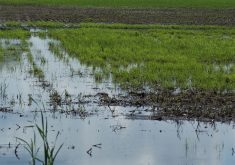The AgriStability compensation rate is going from 80 per cent to 90 per cent for the 2025 program year. It was a predictable response, and prime minister Mark Carney’s Liberals made sure to announce it ahead of a federal election call.
For Canadian farmers facing soft grain prices due to tariff threats from the United States and prohibitive tariffs by China, additional support had been limited to re-establishing the $250,000 interest free component to the Advance Payments Program and an extra $1 billion in lending capacity for Farm Credit Canada.
There was no indication FCC’s lending capacity was a problem, but the announcement made it seem like the government was doing something.
Read Also

Dennis Laycraft to be inducted into the Canadian Agricultural Hall of Fame
Dennis Laycraft, a champion for the beef industry, will be inducted into the Canadian Agricultural Hall of Fame this fall.
In comparison, the AgriStability enhancement is tangible.
In the 2023 program year, the compensation rate was raised from 70 per cent to 80 per cent, and with this change it will be at 90 per cent for 2025.
In addition, the payment cap (maximum payment) will go from $3 million to $6 million for the 2025 program year.
It’s important to note that the increase to the compensation rate will not make more producers eligible for AgriStability support. The payment trigger is still a reference margin drop of more than 30 per cent.
In other words, your program year margin must be less than 70 per cent of your reference margin (average of past years) before support kicks in.
It would have been much more significant for the government to adjust the reference margin trigger to allow producers to more easily qualify, but changing the compensation rate is a logical way to provide producers with an improved backstop in the face of Chinese and American tariffs.
Unfortunately, a lot of producers are not enrolled in AgriStability. While the premium to be enrolled is not onerous, the program is complicated and is typically carried out by a farm’s accountant.
Many producers would no doubt prefer a support program similar to $10 billion being paid to American farmers to compensate for declining farm income.
Payments to American farmers under the Emergency Commodity Assistance Program are based on 2024 seeded acres, with each commodity receiving a different payment per acre.
The initial corn payment will be roughly $43 an acre, soybeans will be nearly $30 and wheat will be almost $31 an acre. Producers are now signing up for the payments.
Whatever money is left in the $10 billion program after the initial payment will be subsequently distributed.
The U.S. Department of Agriculture money is to help with spring seeding costs in the face of dropping net income.
Receiving an acreage payment after a simple application sounds attractive, but it’s a broad brush payment to field crop producers, whether they had a good year or a really bad year, and doesn’t do anything for livestock producers.
Enhancing AgriStability is a targeted approach because the program measures your financial position relative to the past three to five years. Producers not enrolled would be well advised to collect their numbers, work with their accountant and get into the program.
Cow-calf producers have typically received limited support from AgriStability, but with the upswing in calf prices over the past few years, their reference margins should be improving. For grain farmers, crop insurance coverage is dropping, which makes AgriStability support more likely.
Uncertainty is the current economic buzzword. No matter which party wins the federal election, AgriStability is likely to be an important platform for providing farm support.
Kevin Hursh is an agricultural journalist, consultant and farmer. He can be reached by e-mail at kevin@hursh.ca.
















